Chapter IV
4.1. The payments process can be facilitated by evolving appropriate institutional arrangements. Cash payment is best facilitated, for example, by the Reserve Bank issuing bank notes at all its offices and by the Reserve Bank providing a currency chest (to store currency on its behalf) in the premises of the agent (commercial banks, Government treasuries, sub-treasuries) where the Reserve Bank offices do not exist. The currency chest helps to distribute currency all over the country. Other institutional arrangements include agencies like the clearing house, settlement accounts with a major bank or (more often) the Central Bank and a framework of rules and procedures that are accepted by all concerned. Traditional arrangements involved the exchange of cheques, computation of net payment obligations among the participating banks and settlement of claims through funds transfers in the books of the settling bank. In some countries, notably, England, the number of banks participating in clearing, the clearing banks, are limited. Other banks would route their instruments through one of the clearing members. The place where the exchange of instruments occurs and the claims are settled is known as the Clearing House. 4.2. All payment instructions made through the medium of cheques are debit transactions. A debit transaction occurs when the intended recipient initiates the payment transaction by depositing the instrument in his bank. During the course of a business day a number of instruments are deposited with a bank for collection by its customers. These instruments may be drawn on different branches of various banks and a collecting bank has to physically present the instruments for collection to each drawee bank/branch. The clearing system provides a convenient and well established institutional mechanism to take care of the problem of physical delivery of instruments as well as funds transfer between different banks. 4.3. In India, the clearing system is local and confined to a defined jurisdiction covering all the banks and branches situated in the area under a particular zone. The clearing house is a voluntary association of banks under the management of a bank where the settlement accounts are maintained. Wherever Reserve Bank of India has its office (and a banking department), the clearing house is managed by it. In the absence of an office of the Reserve Bank, the clearing house is managed by the State Bank of India, its associate banks and in a few cases by public sector banks. 4.4. Clearing Houses in India: There are 860 Bankers clearing houses in India, of which 840 are managed by State Bank of India and its Associates, 14 by Reserve Bank of India, and the rest 6 by nationalised banks (Figure 4.1). Reserve Bank of India manages 14 clearing houses at Ahmedabad, Bangalore, Bhubaneshwar, Mumbai, Calcutta, Chennai, Guwahati, Hyderabad, Jaipur, Kanpur, Nagpur, New Delhi, Patna and Thiruvananthapuram. These cover most of the major urban and semi-urban centres of economic activity. Other than the major cities and metropolitan centres, the volume and value of cheques cleared are very low. The cheques cleared in the clearing houses managed by Reserve Bank of India account for 62% in terms of volume and 86% in terms of value of the total cheques cleared in the country (Figures 4.2 and 4.3).
 Figure 4.1 : Management of clearing houses
Figure 4.1 : Management of clearing houses
as on March 31, 1998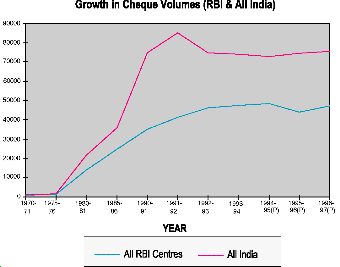 Fig. 4.2. Growth in Cheque Volumes
Fig. 4.2. Growth in Cheque Volumes
(April - March)
State Bank of India (SBI) has the widest network of branches in the country and acts as an agent of the Reserve Bank in centres where the RBI does not have its offices. It is therefore, natural that a vast majority of the clearing houses in the country are managed by the SBI. The rest of the clearing houses are managed by the associate banks of the SBI in the areas of their concentration and in some cases by other public sector banks.
4.5. The membership of the clearing house includes both direct members and sub-members. All the branches of a member bank within the clearing house jurisdiction are eligible to present and receive cheques drawn on any other member bank/branch within the jurisdiction. The sub-members, who are sponsored by a member bank, participate in clearing in the same way as a branch of a member bank.
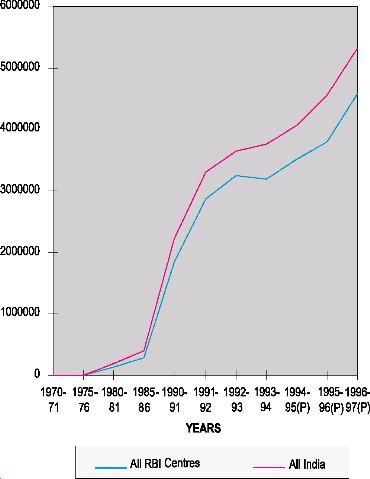 Fig. 4.3. Growth in Cheque Values
Fig. 4.3. Growth in Cheque Values
(April - March)
The membership to the clearing house is through a joint decision of the general body of the clearing house.
4.6. Clearing Structure: The dominant feature of the Indian Banking system is its branch-centered banking. The vast network of branches implies that the logistics of collection and delivery of paper payment instruments becomes formidable. The Mumbai Bankers' Clearing House, for instance, has over 110 members, 261 sub-members and extends over 2400 branches. The clearing infrastructure is designed to address the movement of instruments between the presenting and drawee branches. Each member bank in a centre is represented in the clearing house by its service branch which collects all the instruments from various branches and consolidates them for presentation to all the banks in the clearing house. Similarly, it receives and distributes among its branches all the instruments drawn upon its branches by other banks in the clearing house. The service branch of a bank performs a crucial intermediary role between the clearing house and the branch of a bank.
4.7. Clearing Process: The clearing process begins with the deposit of a cheque in a bank. The cheque (along with other cheques) is delivered to the bank/branch where it is drawn. The cheque is passed for payment if the funds are available and the banker is satisfied about the genuineness of the instrument. The cheques that are unpaid are returned to the presenting bank through another clearing called the Return Clearing. The realisation of the funds occurs after the completion of return clearing and by the absence of an unpaid cheque (Figure 4.4).
4.8. Settlement of Funds: The settlement of funds in clearing occurs at several levels. The aggregate amount or value of cheques presented by a bank on other banks represents the claim by that bank on other banks. Similar claims are made by all the banks on every other bank in the clearing. A net settlement is arrived at the clearing house and the debit or credit position of the bank is determined. These are booked in their current accounts maintained by the settling bank. This represents the inter- bank settlement. The settlement of funds between the service branch and the branch concerned represents the transfer of funds to the branch level. The payment process is completed only when the funds are debited from the drawer's account and credited to the payee's account. This occurs after the completion of the return clearing mentioned earlier (Figure 4.5).
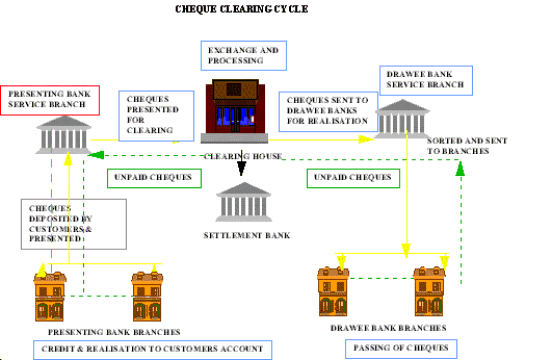 Figure 4.4 - The movement of cheques in local clearing.
Figure 4.4 - The movement of cheques in local clearing.
4.9. Return Clearing: Realisation of a cheque i.e. payment occurs after the cheque that is returned unpaid takes place in this clearing. The aggregate of all items unpaid is debited to the original presenting bank and credited to the drawee bank. The same process is mirrored in the inter-branch settlement at the service branch of a bank. The credit given to the payee on account of the cheque is reversed.
4.10. Inter-branch clearing: Cheques presented by customers drawn on different branches of the same bank need not be sent to the clearing house as the transfer of funds is internal to the bank. The service branch usually acts as a settlement branch for the branches and the instruments are sent to the drawee branches while the inter-branch accounts are credited or debited internally.
4.11. Time lag: The total clearing cycle including the return clearing introduces a time lag in the payments process. The need for physical presentment of the cheque at the branch where it is drawn on, requires the movement of cheques from one place to another. As a result, the recipient of payment has to wait until the collecting banker is fully satisfied that the cheque has been paid. This time lag will continue irrespective of the level of technology and improvements in process, so long as the physical presentment of the cheque is necessary as per the banking law.
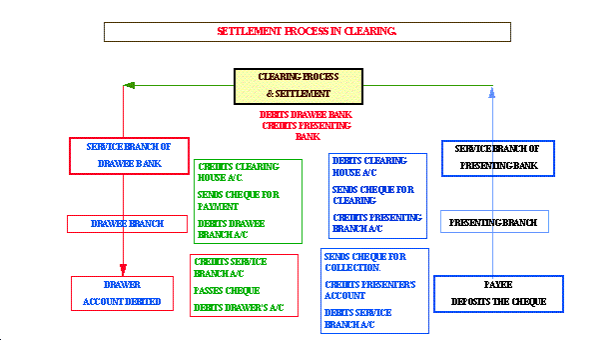 Fig. 4.5. Settlement Process in Clearing
Fig. 4.5. Settlement Process in Clearing4.12. Collection of outstation instruments: As the clearing jurisdiction is local, a separate procedure has evolved for the collection of cheques drawn on banks outside the clearing house area. In this case, the cheques are sent by post for collection to the representative branch or correspondent branch for presentation in the clearing house in the outstation centre. Once the cheque is realised, the proceeds are remitted to the original presenting bank for credit to the customer account. This leads to a significant delay in the payment of these cheques and there is considerable uncertainty regarding the time of realisation. The National Clearing system, described elsewhere, has considerably reduced the time taken for realisation at designated centres.
4.13. Settlement of funds for outstation Items: Due to delays in collection of outstation cheques, various alternative forms of payments instruments are widely used to settle outstation payments. Some of the payment items such as demand drafts, payable at par warrants etc., have been described in the previous chapter. In all these cases, whether cheques or drafts, the question of settlement between paying bank and the collecting bank remains. In the case of demand drafts, the payment is usually internal to the bank and is settled by book transfers using an internal pipe line account maintained in the bank. In the case of 'At par' items, a single account maintained in any branch is debited and various paying branches are paid. Sometimes the layers of intermediation increase as the funds move from a paying bank to its branch at other centre to a collecting bank at that centre. In all these cases, the delays involved in the payments transaction are considerable both for the recipient of the funds as also for the banks involved.
4.14. Prior to 1986, there were no formal regulations and rules governing the transaction of business in the clearing houses. Each Clearing House had its own rules and regulations based on local conventions and convenience. In case of disputes, problem resolution proved to be a tricky exercise.
4.15. In 1986, Reserve Bank of India framed a set of guidelines known as the Uniform Regulations and Rules (URR) for the Bankers' Clearing Houses. These guidelines were prescribed against the backdrop of considerable changes occurring in the functioning of the clearing houses due to the introduction of computerisation in the banking industry.
4.16. The Regulations are designed to provide a uniform framework for the conduct of clearing throughout the country and have been adopted individually by the general body of each clearing house in the country. Individual Clearing Houses are free to frame their own rules consistent with the broad framework provided by the Regulations.
4.17. The Uniform Rules and Regulations represent a significant step forward in providing a formal institutional framework for the payments system in the country. They govern the conduct of the clearing business, prescribe a fair membership criteria and provide for penalties in the case of default. They also explicitly provide for significant oversight function for Reserve Bank of India.
4.18. The Regulations provide for an ex-officio President of the clearing house, who is the officer-in-charge of the bank managing the clearing house. The President is assisted by a Standing Committee comprising of a few representatives of member banks to help him resolve urgent problems.
4.19. All banks including State Co-operative banks, General Post Offices are eligible to become members of the clearing house.
4.20. The Regulations stipulate the maximum value of daily presentations that can be made in the clearing by private commercial banks, central co-operative banks and primary co-operative banks, with reference to their deposit liabilities. The presentation limits, at 10% of the deposit liabilities (which could be relaxed in genuine cases) for each year are fixed on the basis of the deposit liabilities of the previous year. This is a risk control measure introduced to maintain stability in the payments system. This is also an attempt at introducing a measure of stability in the payments system by limiting the volatility of payments demand.
4.21. The Rules provide for Hours of Clearing and Return of Documents. Based on the needs of the members as also local trade and consumer associations, a clearing house may decide on the number of presentation clearings and corresponding return clearings. The jurisdiction of the clearing house i.e., the number of branches covered is specified by the President of the Clearing House and advised to all members and sub-members.
4.23 URR prescribe the mechanism to be followed in settlement in the event of default by a member in meeting its clearing liabilities. In the event of default, all the instruments drawn on the defaulting bank are withdrawn from the settlement process and settlement is effected as if the defaulting bank did not participate in the clearing. All credit due to the bank in respect of the instruments presented by it in the clearing is held in a suspense account and the amount of such instruments returned unpaid is debited to the Suspense account. The balance if any is credited to the defaulting member.
4.24. Settlement activities in India are dispersed through the 860 clearing houses in the country. However, the banks need to maintain liquidity or remit funds to settle their clearing obligations at any or all of the centres of their activity. Surplus funds may be available with a bank at any one centre after the settlement operations are carried out and these funds may need to be transferred to a deficit funds centre. The bank with surplus funds may wish to deploy its surplus funds in a profitable manner in the inter-bank or call money market. A remittance facility therefore, is required to facilitate transfer of funds from one place to another.
4.25. The Reserve Bank is the banker to the Central and State Governments. Tax collections and revenue receipts gathered across the country need to be credited to the Government account at Central Accounts Section (CAS), Nagpur. Similar is the case with the proceeds of Treasury Bill auctions. Funds transfer arrangements between banks, between government accounts and the RBI offices would therefore, be essential to take care of the needs of the payments and settlement process.
4.26. Remittance Facilities Scheme: Reserve Bank of India operates an integrated Remittance Facilities Scheme (RFS) to enable funds transfer between the banks. The RFS Scheme, which came into being on October 1, 1940, facilitates funds transfer between different centres in the country in an expeditious manner with minimum costs. The Scheme is operated by Reserve Bank of India and its agents (banks) including treasuries and sub-treasuries. In other centres, the SBI operates a remittance scheme to enable banks to fund and withdraw from various settlement accounts. In the absence of the SBI, its associate banks or the public sector bank managing the clearing house, provide remittance facility. This enables the movement of settlement funds between all the clearing centres.
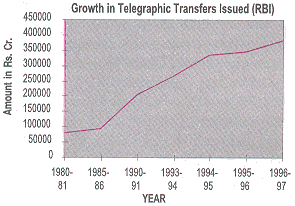 Fig. 4.6. TTs Issued
Fig. 4.6. TTs Issued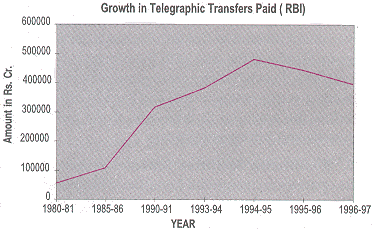 Fig. 4.7 TTs paid
Fig. 4.7 TTs paid
4.27. There are no limits on the amounts that can be transferred under the RFS in the case of the Reserve Bank and the agencies. Limits have however, been prescribed for issue and encashment of remittances at treasuries. The Central and State governments are entitled to remit funds free of charge throughout the country. In the case of banks, certain charges have been prescribed, as also the minimum amounts which can be remitted.
|